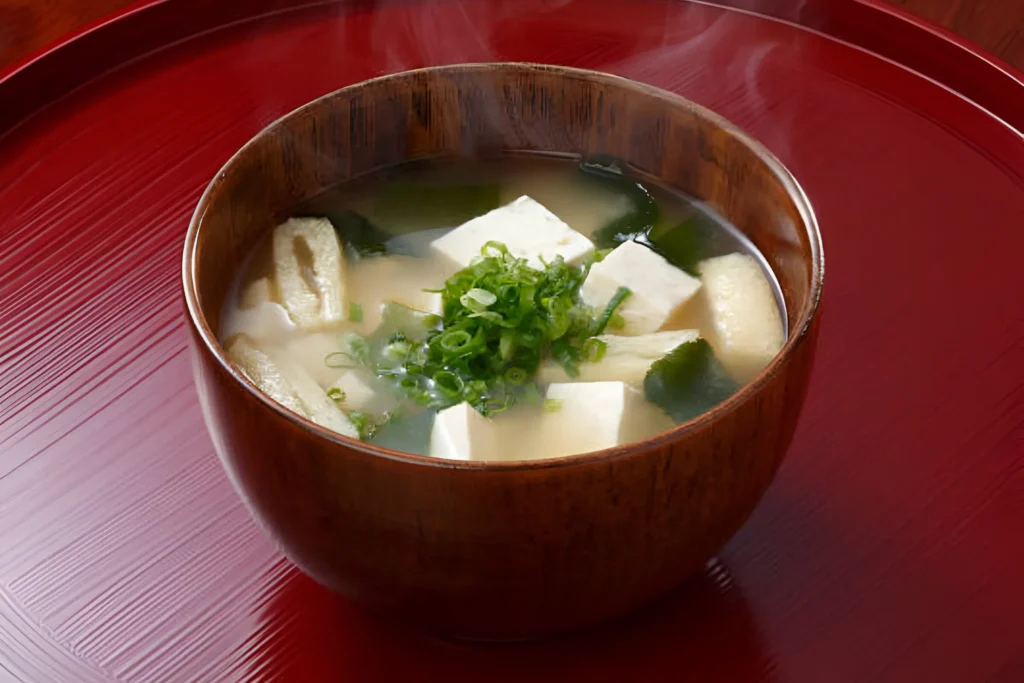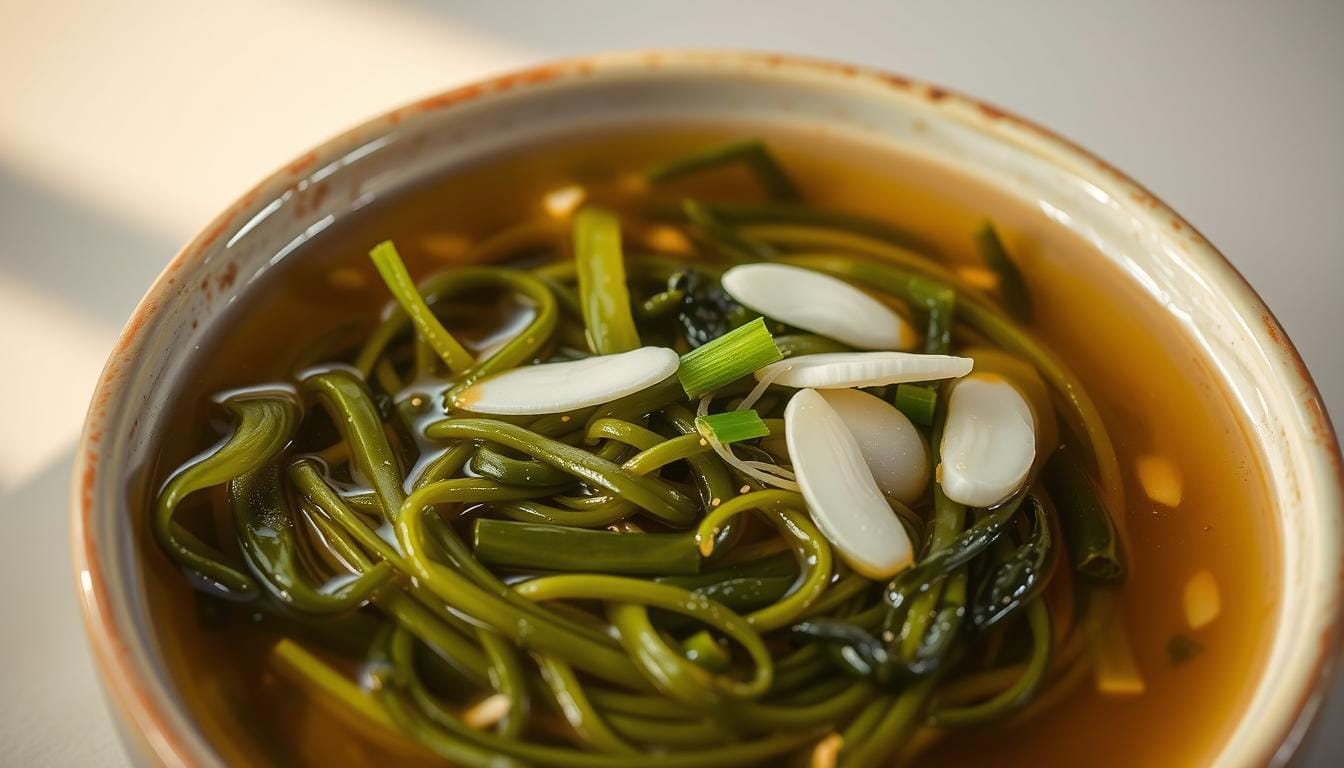How to Master Seaweed for Miso Soup with 4 Simple Tips

Discovering the perfect seaweed for miso soup can change your cooking game. Traditional Japanese cuisine loves the rich flavors and health perks of the right seaweed. Learning to prepare seaweed well will make your miso soup stand out.
Seaweed in miso soup is more than just an ingredient. It’s about finding the right mix of flavor, texture, and cultural value. These four easy tips will help you make amazing miso soup with top-notch seaweed, whether you’re cooking at home or exploring new recipes.
Starting an authentic miso soup journey means picking the right seaweed and knowing its special traits. Our detailed guide will show you how to add this healthy ingredient to your cooking.
Key Takeaways
- Understand the cultural importance of seaweed in miso soup
- Learn proper seaweed selection techniques
- Discover nutritional benefits of different seaweed varieties
- Master rehydration and preparation methods
- Explore traditional and modern seaweed preparation approaches
Understanding the Essential Role of Seaweed in Traditional Miso Soup
Seaweed is a key ingredient in traditional miso soup. It adds depth, nutrition, and cultural value to this Japanese dish. Seaweed turns a simple broth into a culinary masterpiece.
Cultural Significance in Japanese Cuisine
Seaweed is more than food in Japanese cooking. It shows the deep bond between Japanese culture and the ocean. Families have used seaweed in miso soup for generations, sharing marine harvest traditions.
- Represents oceanic heritage
- Connects generations through cooking
- Embodies respect for natural ingredients
Nutritional Benefits of Seaweed
Seaweed is a nutritional powerhouse in miso soup. It’s full of minerals, vitamins, and antioxidants, boosting health. Its low calories make it great for any diet.
| Nutrient | Benefits |
|---|---|
| Iodine | Supports thyroid function |
| Vitamin B12 | Enhances energy metabolism |
| Antioxidants | Fights cellular damage |
Types of Traditional Soup Base
Seaweed is vital for miso soup’s flavor. Different types give the broth unique tastes, making each recipe special.
- Kombu: Creates rich, umami base
- Wakame: Adds delicate marine flavor
- Nori: Provides intense sea essence
Selecting the Perfect Seaweed for Miso Soup
Choosing the right seaweed for miso soup can make a big difference. Not all seaweed is the same. Knowing what makes each type special is key to a great miso soup.
When picking seaweed for miso soup, keep these points in mind:
- Freshness of the dried seaweed
- Texture and quality
- Origin and harvesting methods
- Color and appearance
Choosing high-quality seaweed is essential for a tasty miso soup. Look for signs of premium seaweed:
| Quality Indicator | What to Look For |
|---|---|
| Color | Deep green or dark with consistent shade |
| Texture | Crisp, not brittle or overly fragile |
| Packaging | Sealed, moisture-free packaging |
| Origin | Preferably Japanese coastal regions |
Experts say to buy seaweed from Asian grocery stores or online. Inspect the packaging carefully for any damage or moisture.
Each seaweed type brings its own taste and health benefits. Your choice will greatly affect your miso soup’s flavor.
Wakame vs Kombu: Choosing the Right Seaweed Variety
When making a traditional miso soup, picking the right seaweed is key. Wakame and kombu are two top choices, each adding something special to your soup.
Knowing the differences between these seaweeds will make your miso soup taste better and be more nutritious.
Characteristics of Wakame
Wakame is a soft, green seaweed with a sweet taste. Its thin leaves add a gentle texture to miso soup. Wakame is also full of nutrients like iodine, calcium, magnesium, and vitamin A.
Properties of Kombu
Kombu is a thick, dark seaweed with a strong umami taste. It’s essential for making dashi, a traditional Japanese stock. Kombu is known for its dense texture, rich mineral taste, and high glutamate content.
Flavor Profiles Compared
| Characteristic | Wakame | Kombu |
|---|---|---|
| Flavor Intensity | Mild | Strong |
| Texture | Delicate | Thick |
| Best Used In | Light soups | Broths and stocks |
When picking tofu miso soup, think about what you like and the recipe you’re using. Wakame is softer and milder, while kombu is richer and more intense.
Essential Kitchen Tools for Preparing Seaweed
Making the perfect miso soup is more than just knowing how. The right tools can make a big difference. Whether you’re starting with miso paste or improving your skills, the right equipment is key.
- Sharp Japanese-style knife for precise seaweed cutting
- Large ceramic or glass mixing bowl
- Fine-mesh strainer for rinsing
- Cutting board dedicated to seafood ingredients
Choosing top-notch tools is important for seaweed preparation. A razor-sharp knife gives clean cuts without tearing seaweed. Glass or ceramic bowls keep flavors safe during soaking.
| Tool | Purpose | Recommended Material |
|---|---|---|
| Knife | Precise seaweed cutting | High-carbon stainless steel |
| Strainer | Rinsing and draining | Stainless steel fine-mesh |
| Cutting Board | Safe ingredient preparation | Bamboo or wood |
Pro tip: Get tools made for Japanese cooking to improve your miso soup. Keep your tools clean and well-maintained. This helps keep their quality and stops flavors from mixing.
The Art of Rehydrating Dried Seaweed
Preparing seaweed for miso soup needs careful attention. Rehydrating dried seaweed makes it tender and flavorful. Knowing the right techniques is key to a great experience.
Rehydrating seaweed is vital for miso soup. Each type of seaweed has its own method. But the basic steps are the same.
Proper Soaking Techniques
Follow these steps for the best seaweed in your miso soup:
- Use cold, clean water for soaking
- Gently separate dried seaweed pieces before submerging
- Avoid using hot water, which can make seaweed tough
- Rinse seaweed thoroughly after soaking
Timing and Temperature Guidelines
The right timing and temperature are key for rehydrating. Here’s a quick guide for different seaweed varieties:
| Seaweed Type | Soaking Time | Water Temperature |
|---|---|---|
| Wakame | 5-10 minutes | Cold water |
| Kombu | 15-30 minutes | Room temperature |
Pro tip: Always taste your rehydrated seaweed. You want it to be delicate and slightly chewy. This will make your miso soup even better.
Common Mistakes When Using Seaweed for Miso Soup
Preparing seaweed for miso soup can be tricky. Many home cooks make simple mistakes that can ruin the delicate flavor and texture of this traditional Japanese dish. Understanding these common pitfalls will help you create a perfect bowl of miso soup every time.
- Over-soaking seaweed: This is one of the most frequent errors when preparing miso soup. Seaweed can quickly become mushy and lose its delicate texture if left in water too long.
- Incorrect water temperature: Using water that’s too hot or too cold can impact the seaweed’s quality and flavor profile in your miso soup.
- Improper storage: Dried seaweed needs careful handling to maintain its nutritional value and taste.
When exploring whats in miso soup, seaweed plays a key role. The key is to treat this ingredient with care and precision. Beginners often make the mistake of using too much seaweed, which can overwhelm the delicate balance of flavors in traditional miso soup.
“Seaweed is an art, not just an ingredient. Treat it with respect.” – Japanese Culinary Wisdom
To avoid these common pitfalls, follow these quick tips:
- Soak seaweed briefly – just a few minutes is enough
- Use room temperature water for rehydration
- Store dried seaweed in an airtight container away from moisture
- Measure seaweed carefully to maintain the perfect miso soup balance
Remember, mastering seaweed preparation takes practice. Each type of seaweed used in miso soup has unique characteristics that require specific handling. Pay attention to the details, and you’ll soon create authentic, delicious miso soup that rivals traditional Japanese restaurants.
Mastering the Perfect Seaweed-to-Broth Ratio
Creating the perfect tofu miso soup needs careful balance of seaweed and broth. The right mix can turn your soup into something special. It ensures a perfect blend of flavors and textures.
Knowing the right seaweed-to-broth ratio is key for a true Japanese taste. The type of seaweed and the soup size affect the measurements.
Measurement Guidelines for Seaweed
Here are the essential tips for seaweed in miso soup:
- For one serving, use about 2-3 grams of dried seaweed
- For bigger batches, increase the seaweed amount proportionally
- Soak dried seaweed in water before adding it to the broth
Adjusting Ratios for Different Soup Sizes
The size of your miso soup recipe changes with the number of servings. Here’s a simple guide:
| Servings | Dried Seaweed (grams) | Broth Volume (cups) |
|---|---|---|
| 1-2 servings | 2-3 | 2-3 |
| 3-4 servings | 5-6 | 4-5 |
| 5-6 servings | 8-10 | 6-7 |
Pro tip: Always taste and adjust the seaweed quantity to suit your personal preference.
“The art of miso soup lies in finding your perfect balance.” – Japanese Culinary Wisdom
Combining Seaweed with Other Miso Soup Ingredients

Making a tasty tofu miso soup is all about mixing ingredients right. Seaweed is key for adding flavor and nutrients to your soup.
When looking at what’s in miso soup, think about these important mixes:
- Tofu and Seaweed: Soft tofu goes well with wakame seaweed, making a smooth and light soup
- Green Onions and Kombu: Green onions add a sharp taste that matches kombu’s deep umami
- Mushrooms and Dried Seaweed: Shiitake mushrooms add earthiness when mixed with dried seaweed
It’s all about finding harmony in your ingredients. Start with a little seaweed and add more as you like. Each seaweed type adds its own special touch to your soup.
“The art of miso soup is in balancing subtle flavors and textures” – Traditional Japanese Cooking Wisdom
Try different mixes to find your favorite miso soup. Using fresh, quality ingredients is essential for a true and tasty dish.
Storage Tips for Fresh and Dried Seaweed
Storing seaweed for miso soup right is key to keeping its quality and taste. Whether it’s fresh or dried, the right storage can make it last longer. This way, your miso soup will always taste great.
Seaweed types need different storage to keep their nutrients and flavor. Knowing these methods helps keep your seaweed fresh for your next miso soup.
Optimal Storage Conditions for Dried Seaweed
Dried seaweed for miso soup needs careful storage to avoid moisture. Here are the key steps:
- Store in an airtight container
- Keep away from direct sunlight
- Maintain a cool, dry environment
- Avoid humid areas in your kitchen
Extending the Shelf Life of Seaweed
To make your seaweed last longer, try these tips:
- Refrigerate opened packages
- Use vacuum-sealed bags for long-term storage
- Check expiration dates regularly
- Inspect for signs of moisture or discoloration
Pro tip: Properly stored dried seaweed can last up to one year. This ensures you always have top-quality ingredients for your favorite miso soup recipes.
Quick Preparation Methods for Busy Weeknight Soups
Making a tasty soup doesn’t have to take a lot of time. With some smart techniques, you can whip up miso soup from paste in minutes. It’s perfect for those busy weeknights.
Speed is important when making your miso soup. Start by having a few key ingredients ready. Instant dashi packets and pre-cut dried seaweed can cut down your prep time a lot.
- Keep dried seaweed in a sealed container for quick access
- Stock high-quality miso paste in the refrigerator
- Prepare pre-chopped green onions in advance
Your strategy for quick miso soup should be all about fast prep. Rehydrate seaweed quickly by using warm water instead of soaking for extended periods. Most dried seaweed only needs 3-5 minutes to get tender and tasty.
For those who are always on the go, here are some tips for making miso soup fast:
- Use hot water from an electric kettle to speed up rehydration
- Choose quick-dissolving miso paste varieties
- Keep pre-cut tofu and garnishes in your refrigerator
Professional chefs say to measure miso paste ahead of time and have all your ingredients ready. This makes making miso soup easy and fun.
Advanced Techniques for Enhanced Seaweed Flavor
To make tofu miso soup taste better, you need skill and knowledge. Both professional chefs and home cooks know that making seaweed taste great is all about how you prepare it.
Getting the most out of tofu miso soup takes precision and creativity. Learning advanced ways to enhance flavor can turn simple ingredients into amazing dishes.
Pre-Soaking Techniques for Maximum Flavor
Soaking seaweed for miso soup is more than just getting it wet. It’s a skill that can really boost taste and texture. Here are some pro tips:
- Cold water soak for delicate flavor preservation
- Warm water immersion to release deeper umami notes
- Salt-water solution for enhanced mineral absorption
- Kombu-infused liquid for extra depth
Seasoning Options to Elevate Seaweed
Seasoning can turn basic seaweed into a gourmet ingredient for tofu miso soup. Try these ways to add flavor:
- Toasted sesame oil drizzle
- Gentle rice vinegar splash
- Microplaned fresh ginger
- Finely chopped green onions
By mastering these advanced seaweed preparation techniques, your soup will be amazing. Remember, practice and patience are essential for creating great flavors.
Seasonal Variations in Seaweed Selection

Making the perfect soup means knowing how seasons change seaweed choices. Each season brings special seaweed types that can change how your miso soup tastes.
In summer, choose lighter tofu soup. Arame and wakame add cool, light flavors. They’re thin and soak up broth fast, making a refreshing soup.
- Summer Seaweed Options:
- Arame
- Wakame
- Thin-cut kombu
- Winter Seaweed Choices:
- Thicker kombu
- Robust hijiki
- Dense nori varieties
In winter, go for heartier seaweed in your miso soup. Thick kombu and dense hijiki add rich, deep umami. They’re perfect for warm, rich broths of winter.
“Seasonal seaweed selection is an art that elevates traditional soup from good to extraordinary.” – Japanese Culinary Tradition
Don’t forget, local and fresh seaweed is key. Visit your local Asian grocery or specialty market for the best seasonal seaweed for your miso soup.
Health Benefits of Including Seaweed in Your Miso Soup
Adding seaweed to your miso soup is more than just a flavor upgrade. It’s a nutritional powerhouse. Seaweed brings a wealth of health benefits that can boost your overall well-being.
Seaweed in miso soup is a nutritional goldmine. It’s packed with nutrients your body needs. Here are some key benefits:
- Rich in iodine for optimal thyroid function
- Provides essential minerals like iron and magnesium
- Contains powerful antioxidants that combat cellular damage
- Supports digestive health through natural fiber content
Each type of seaweed in soup offers unique benefits. Wakame, for example, is a great source of omega-3 fatty acids. Kombu, on the other hand, is rich in minerals. These marine wonders can strengthen your immune system.
Regularly enjoying soup with seaweed can help your heart, control blood sugar, and aid in weight management. It’s low in calories but full of nutrients, making it a great choice for a healthy diet.
Embrace seaweed in your soup as a delicious pathway to enhanced nutrition and wellness.
Troubleshooting Common Seaweed Problems
Making perfect miso soup from paste can be tricky, thanks to seaweed. To master this, you need to know some key troubleshooting tips. These will boost your cooking skills.
Seaweed can cause texture and flavor issues in your soup. These are common problems for home cooks making this traditional Japanese dish.
Texture Challenges with Seaweed
Seaweed in your soup can lead to texture problems:
- Overly Chewy Seaweed: This is often due to not soaking it right or cooking it too long
- Slimy Consistency: This happens when you soak dried seaweed too much
- Tough Fragments: This means the seaweed didn’t soak enough
Flavor Adjustment Strategies
Getting the seaweed’s taste right is key. Here’s how to balance it:
- Rinse seaweed well to cut down saltiness
- Start with small amounts to control the flavor
- Add ingredients like tofu or green onions to complement it
With these tips, your soup will be better. It will show off seaweed’s flavors without overpowering the dish.
Sustainable Sourcing of Seaweed for Miso Soup
Choosing sustainable seaweed for soup is key to protecting our oceans. Your food choices can greatly affect the environment. By choosing responsibly sourced seaweed, you help keep our oceans healthy and support fair food production.
When picking seaweed for soup, keep these sustainability points in mind:
- Wild-harvested vs. cultivated seaweed methods
- Ecological impact of harvesting techniques
- Certification from marine conservation organizations
- Carbon footprint of seaweed production
Sustainable seaweed sourcing means understanding the ocean’s complex ecosystem. Not all seaweed harvesting practices are created equal. Seek out producers who care about the environment.
| Sustainability Criteria | Environmental Impact |
|---|---|
| Regenerative Farming | Minimal ecosystem disruption |
| Low-Impact Harvesting | Preserves marine habitat |
| Organic Certification | Reduces chemical pollution |
“Sustainable seaweed sourcing is not just about food – it’s about protecting our planet’s delicate marine ecosystems.”
For your soup, choose seaweed brands that show they source sustainably. Look for marine stewardship certifications. Support companies that work to protect our oceans.
Conclusion
Making miso soup with seaweed is an art that changes your cooking at home. It’s about knowing how to pick, prepare, and use seaweed. This turns a simple dish into a masterpiece that shows off Japanese cuisine.
Exploring seaweed types like wakame and kombu is key. It helps you make miso soup rich and tasty. The trick is to learn how to soak seaweed right, keep the right mix of ingredients, and try different ways to make it.
Getting good at making miso soup takes time and trying new things. Your effort will lead to a soup that’s not just good for you but also connects you to a long tradition. Start with the basics, keep learning about seaweed, and enjoy the tasty results of your hard work.
See making miso soup at home as a chance to show off your cooking skills. Let your creativity make each bowl of soup special and full of flavor.
FAQ
What types of seaweed are best for miso soup?
Wakame and kombu are top picks for miso soup. Wakame adds a soft texture and a light taste. Kombu, on the other hand, gives a deep umami flavor. You can mix both for a richer taste.
How do I properly rehydrate dried seaweed for miso soup?
Soak dried seaweed in cold water for 5-10 minutes. For wakame, use clean water and gently move it to remove dirt. Drain and cut into small pieces after. For kombu, soak briefly and remove before boiling to avoid sliminess.
How much seaweed should I use in my miso soup?
Use 1-2 tablespoons of dried seaweed for every 2 cups of soup. Start small and adjust to taste. Remember, seaweed expands when soaked, so a little goes a long way.
Can I store leftover seaweed for future use?
Yes, keep dried seaweed in an airtight container in a cool, dry place. For fresh seaweed, refrigerate and use within 2-3 days. Always check for moisture or color changes before using.
Is seaweed in miso soup nutritionally beneficial?
Absolutely! Seaweed is full of minerals like iodine, calcium, and iron. It also has vitamins and antioxidants. It’s low in calories and great for your thyroid, digestion, and immune system.
What’s the difference between wakame and kombu?
Wakame is thin and mild, often used as a garnish. Kombu is thicker and more intense, used for dashi. Both add unique flavors to your soup.
How can I avoid common mistakes when using seaweed in miso soup?
Don’t over-soak seaweed to avoid sliminess. Use cold water and add it towards the end of cooking. Start with a small amount and adjust to taste.
Can I use fresh or packaged seaweed for miso soup?
Both fresh and packaged seaweed work well. Packaged seaweed is convenient and lasts longer. Fresh seaweed offers a brighter flavor. Choose high-quality seaweed from a reputable source.
Add a Dash of Your Thoughts!
There are no reviews yet. Be the first one to write one.






